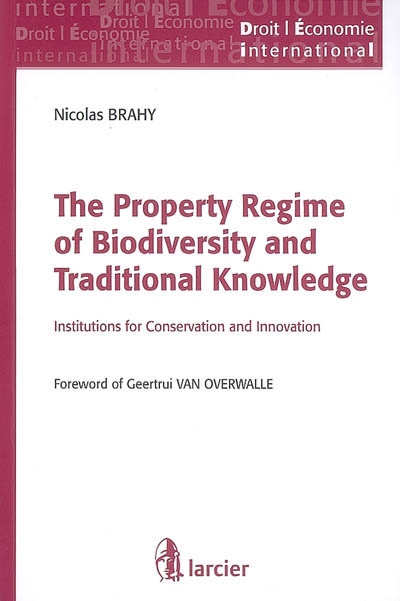en savoir plus

Carte fidélité
Permet à tous ses détenteurs d'obtenir 5% de réduction sur tous les livres lors du retrait en magasin (réduction non cumulable avec les réductions de type étudiant).
Offre également un certain nombre d'avantages auprès de nos partenaires.
Wishlist
Avec les favoris, retrouvez dans un espace les sélections effectuées au fur et à mesure de vos navigations dans le site.
Constituez pour votre usage personnel vos listes de livres en prévisions d'achats futurs et votre sélection d'articles, dossiers, événements, vidéos ou podcasts préférés ou à découvrir plus tard...
Il suffit simplement de cliquer sur "Ajout Favori" sur chaque page qui vous intéresse pour les retrouver ensuite dans votre espace personnel.
Requiert un compte Mollat
Mes Alertes
Requiert un compte Mollat
The property regime of biodiversity and traditional knowledge : institutions for conservation and innovation
Auteur : Nicolas Brahy
en savoir plus
Résumé
A partir d'une approche juridique, économique et historique, la Convention sur la biodiversité est expliquée, ainsi que la façon dont les pays fournisseurs et les bio-industries s'efforcent de la mettre en oeuvre. Dans une perspective plus large d'organisation de l'innovation et de la conservation, l'enjeu de leur financement est présenté. ©Electre 2025
Lire la Quatrième de couverture
Réduire la Quatrième de couverture
The Property Regime of Biodiversity and Traditional Knowledge
How can we simultaneously conserve biodiversity and use its components (genetic resources) to create new medicines and better seeds ?
Signed in 1992, at the Earth Summit in Rio, the Convention on Biological Diversity answers this question by resorting to intellectual property rights on living material with the objective to create a market for genetic resources. Fifteen years later, we cannot but observe that biodiversity keeps eroding and that the proliferation of intellectual property rights hinders research and innovation on new medicines and seeds.
Combining legal, economical and historical approaches, this book explains in simple terms how the Biodiversity Convention came into existence, and how the providing countries and bio-industries (pharmaceutical and seeds industry) are striving to implement it, and why the Convention and its project of a market for genetic resources do not work properly. The book, then, examines new orientations and suggests avenues for solutions.
What makes this book different ? It puts the Convention on Biological Diversity back in the wider context of the organization of both innovation and conservation of nature. This approach highlights what is really at stake :
Financing innovation and conservation : what should be the distribution of tasks between the market and public funding ?
Coordinating the agents of conservation and innovation (providing countries, local communities, universities, firms, etc) : what should be the distribution of tasks between the market and regulation ?
Fiche Technique
Paru le : 11/02/2008
Thématique : Grands thèmes droit public
Auteur(s) : Auteur : Nicolas Brahy
Éditeur(s) :
Larcier Intersentia
Collection(s) : Droit, économie international
Contributeur(s) : Préfacier : Geertrui Van Overwalle
Série(s) : Non précisé.
ISBN : 978-2-8044-2895-2
EAN13 : 9782804428952
Reliure : Broché
Pages : 435
Hauteur: 24.0 cm / Largeur 16.0 cm
Épaisseur: 2.5 cm
Poids: 720 g
